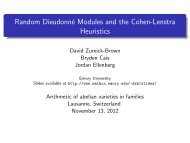alternative lecture notes - Rational points and algebraic cycles
alternative lecture notes - Rational points and algebraic cycles
alternative lecture notes - Rational points and algebraic cycles
Create successful ePaper yourself
Turn your PDF publications into a flip-book with our unique Google optimized e-Paper software.
Example 11.11. (Colimits do not preserve weak equivalences in general.) Let M = SSet<br />
<strong>and</strong> D be the category defined by the following graph<br />
<br />
d 1 <br />
d 2<br />
We consider M D with the projective model structure. Let A = (A 1 , A 2 , A 3 ) ∈ M D be the<br />
object defined by A 1 = {pt ′ , pt ′′ }, A 2 = A 3 = pt. The colimit of A is a single point. Let<br />
object B = (B 1 , B 2 , B 3 ) ∈ M D be defined by B 1 = {pt ′ , pt ′′ }, B 2 = B 3 = line segment,<br />
where the non-identity maps send pt ′ , pt ′′ to the end <strong>points</strong> of both line segments. The<br />
colimit of B is a circle. There is an obvious element of Hom M D(B, A) that collapses the<br />
line segments to <strong>points</strong>. This map is a weak equivalence, since it is a weak equivalence<br />
levelwise. The induced map colim B → colim A collapses a circle onto a point, so is not a<br />
weak equivalence. Therefore, colim does not preserve weak equivalences in general.<br />
Exercise: Let A be an object in M D . If A 1 is a cofibrant object <strong>and</strong> A 1 → A 2 <strong>and</strong><br />
A 1 → A 3 are cofibrations in M, then A is cofibrant in M D with the projective model<br />
structure. (Hint: use that the cofibrations are exactly the morphisms satisfying the LLP<br />
with respect to trivial fibrations.)<br />
From the exercise it follows that the colimit of the B of Example 11.11 is in fact the<br />
homotopy colimit.<br />
Example 11.12. Here is how to take the cofibrant replacement A cof of A as in Example<br />
11.11. Set A cof<br />
1 = A 1 , <strong>and</strong> define A cof<br />
2 <strong>and</strong> A cof<br />
3 respectively as the mapping cylinders of<br />
A 1 → A 2 <strong>and</strong> A 1 → A 3 . There are canonical inclusions A cof<br />
1 → A cof<br />
2 <strong>and</strong> A cof<br />
1 → A cof<br />
3 .<br />
Taking the colimit can be described geometrically as gluing the two mapping cylinders along<br />
the images of A 1 .<br />
Dually, if B is a diagram in M D , the homotopy limit turns out to be<br />
holim(B) = B 2 × h B 1<br />
B 3<br />
= {(b 2 , b 3 , p) : b 2 ∈ B 2 , b 3 ∈ B 3 , p : [0, 1] → B 1 : p(0) = b 2 , p(1) = b 3 } .<br />
Let G be a group, considered as a category with one object. Then we have the Quillen<br />
adjunction<br />
colim: SSet G <br />
SSet: const<br />
The colimit maps a simplicial G-set to its orbit space. Recall that an object of SSet G is<br />
cofibrant if <strong>and</strong> only if the action is free. To compute the homotopy colimit of X, one<br />
replaces X by X ×EG, which is a cofibrant replacement since EG is contractible. Hence the<br />
homotopy colimit of X is weakly equivalent to (X × EG)/G. This is the Borel construction<br />
which we encountered in Section 2. When X is a point with trivial G-action, we get that<br />
the homotopy colimit of X is BG, the classifying space of G.<br />
Dually, we have:<br />
const: SSet SSet G : lim<br />
27<br />
d 3



